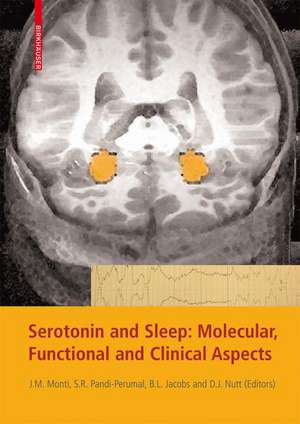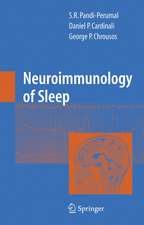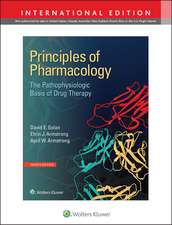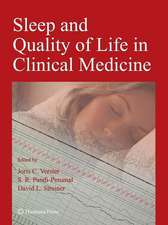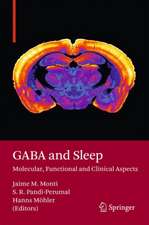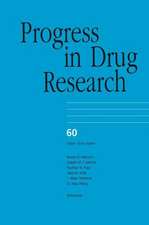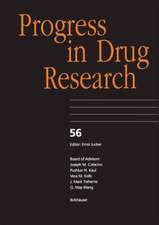Serotonin and Sleep: Molecular, Functional and Clinical Aspects
Editat de Jaime M. Monti, S. R. Pandi-Perumal, Barry L. Jacobs, David J. Nutten Limba Engleză Hardback – 17 dec 2007
Preț: 1427.98 lei
Preț vechi: 1503.14 lei
-5% Nou
Puncte Express: 2142
Preț estimativ în valută:
273.25€ • 292.19$ • 227.83£
273.25€ • 292.19$ • 227.83£
Carte tipărită la comandă
Livrare economică 18 aprilie-02 mai
Preluare comenzi: 021 569.72.76
Specificații
ISBN-13: 9783764385606
ISBN-10: 376438560X
Pagini: 630
Ilustrații: XXVIII, 621 p. 80 illus., 3 illus. in color.
Dimensiuni: 165 x 235 x 37 mm
Greutate: 0.87 kg
Ediția:2008
Editura: Birkhäuser Basel
Colecția Birkhäuser
Locul publicării:Basel, Switzerland
ISBN-10: 376438560X
Pagini: 630
Ilustrații: XXVIII, 621 p. 80 illus., 3 illus. in color.
Dimensiuni: 165 x 235 x 37 mm
Greutate: 0.87 kg
Ediția:2008
Editura: Birkhäuser Basel
Colecția Birkhäuser
Locul publicării:Basel, Switzerland
Public țintă
ResearchCuprins
Evolution of concepts.- Changing concepts on the role of serotonin in the regulation of sleep and waking.- The dorsal raphe nucleus and median raphe nucleus: organization and projections.- Topographic organization and chemoarchitecture of the dorsal raphe nucleus and the median raphe nucleus.- Efferent and afferent connections of the dorsal and median raphe nuclei in the rat.- Reciprocal connections between the suprachiasmatic nucleus and the midbrain raphe nuclei: A putative role in the circadian control of behavioral states.- Serotonin receptors.- Localization of 5-HT receptors in the mammalian cortex.- Molecular biology of 5-HT receptors.- Electrophysiology of serotonergic neurons and the regulation of serotonin release.- Brain serotonergic neuronal activity in behaving cats.- Electrophysiological studies on serotonergic neurons and sleep.- Role and origin of the GABAergic innervation of dorsal raphe serotonergic neurons.- Regulation of serotonin release by inhibitory and excitatory amino acids.- Neurophysiological aspects of the regulation of serotonin neurons by the orexinergic system.- Serotonin receptors and the regulation of behavioural state.- Serotonin and dreaming.- Involvement of the 5-HT1A and the 5-HT1B receptor in the regulation of sleep and waking.- Mechanisms involved in the inhibition of REM sleep by serotonin.- Effect of 5-HT2A/2B/2C receptor agonists and antagonists on sleep and waking in laboratory animals and humans.- Effect of the selective activation of serotonin 5-HT3 receptors on sleep and waking.- 5-HT7 receptor modulation of sleep patterns.- Sleep and waking in mutant mice that do not express various proteins involved in serotonergic neurotransmission such as the serotonergic transporter, monoamine oxidase A, and 5-HT1A, 5-HT1B, 5-HT2A, 5-HT2C and 5-HT7 receptors.- Circadian control by serotonin and melatonin receptors: Clinical relevance.- Serotonergic mechanisms contributing to arousal and alerting.- Relevance of serotonin to clinical disorders and drug actions.- Contribution of chemosensitive serotonergic neurons to interactions between the sleep-wake cycle and respiratory control.- Obstructive sleep apnea: The potential for serotonergic pharmacotherapies.- The effects of antidepressant drugs and 5-HT1A agonists on human sleep.- The effect of typical and atypical antipsychotic drugs on sleep of schizophrenic patients.
Textul de pe ultima copertă
Serotonin and Sleep: Molecular, Functional, and Clinical Aspects covers the complete spectrum of the field and explores the link between the latest basic molecular, functional, and clinical aspects of serotonin and the practice of sleep medicine. The volume focuses on 24 different areas of research, with special emphasis relating the state of basic and clinical research to potential applications: changing concepts in serotonin research, topographic organization and chemoarchitecture, receptor mechanisms – its organization and regulation of behavioral states, electrophysiological mechanisms – in vitro, in vivo, and behaving animals and other areas of molecular neurobiology. Also highlighted are studies related to the circadian control of behavioral states, and mechanisms involved in the serotonergic inhibition of REM sleep. Such discussion has profound implications for the basic biology of serotonin.
This unique volume not only explores the cutting-edge research, and the relationship of serotonin to laboratory animals as well as human sleep; it also explores the relevance of serotonin to clinical disorders such as depression, schizophrenia, and sleep apnea and brings these areas together to continue to promote the rapid expansion of knowledge in the area of serotonergic neurotransmission across behavioral states.
Written by an international cadre of researchers, this timely volume provides an up-to-date summary of what may be the only view on serotonin from the perspectives of neurobiologists, neuroanatomists, cell biologists, psychiatrists, neuropharmacologists, as well as sleep researchers.
This unique volume not only explores the cutting-edge research, and the relationship of serotonin to laboratory animals as well as human sleep; it also explores the relevance of serotonin to clinical disorders such as depression, schizophrenia, and sleep apnea and brings these areas together to continue to promote the rapid expansion of knowledge in the area of serotonergic neurotransmission across behavioral states.
Written by an international cadre of researchers, this timely volume provides an up-to-date summary of what may be the only view on serotonin from the perspectives of neurobiologists, neuroanatomists, cell biologists, psychiatrists, neuropharmacologists, as well as sleep researchers.
Caracteristici
Overview of current approaches and medications Up-to-date reference resource Interesting and readable Includes supplementary material: sn.pub/extras
